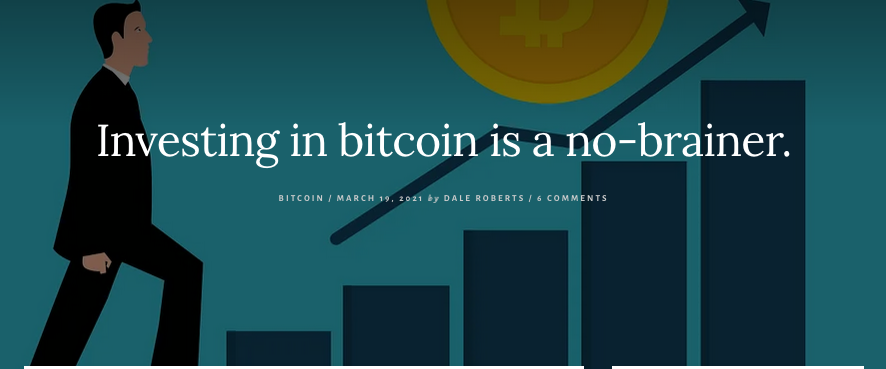By Dale Roberts, Cutthecrapinvesting
Special to the Financial Independence Hub
In the Fall of 2020 I initiated a position in bitcoin by way of a closed end fund from 3iQ Digital Asset Management. The initial purchase created a 2.5% portfolio weighting. The explosive price increase quickly took me above my target of a 5% portfolio weighting. I am embracing bitcoin as a core portfolio asset. It is one of the portfolio risk managers. This post will demonstrate why investing in bitcoin is a no-brainer.
To my eye, bitcoin is digital gold. It is a store of value. What makes bitcoin a store of value is due to the fact that it is a currency (digital) and it is scarce. There are only 18,500,000 million coins in circulation (it’s less than that as a few million coins were lost due to owners losing their keys) and the total creation of bitcoin will be capped at 21,000,000 coins. It is the opposite of inflationary.
It is scarce and it will be finite in supply.
Many will say that it is “the hardest currency on earth.”
On the flipside, central banks around the world are printing and borrowing monies at a historic rate. Those fiat currencies will be devalued. This also creates the threat of inflation.
What is bitcoin?
For the go-to post that will help you on your journey to understanding bitcoin, please have a read of should you invest in cryptocurrency?
That post was the result of hundreds of hours of research. In the process I consulted with individuals and firms that had put in thousands of hours of research and due diligence.
One such individual is Arthur Salzer, the CEO of Northland Wealth Management. Northland was the recent winner in North America in the category of Best Family Office Under $2 billion.
A family office firm will manage and protect the wealth of more affluent families. They will typically embrace the same style and financial management techniques employed by pension funds, sovereign wealth funds and endowments such as Yale and Harvard.
Protect and grow assets over generations
Given that generational goal I was more than surprised to know that Northland was using bitcoin as a core portfolio asset even more than two years ago. They were early adopters to say the least. And that confidence in bitcoin as a portfolio asset was the result of extensive due diligence.
Clients have benefitted tremendously.
According to a new generation in the financial industry, unless something gets in the way, crypto is on the path to even greater credibility and increased adoption. We’re at the foothills of this long trend of financialization and institutional adoption.
I asked Arthur Salzer of Northland Wealth Management to describe his extensive bitcoin educational journey, and why he has the confidence to use bitcoin as a portfolio asset for Northland family clients.
From Arthur …
The bitcoin journey
Of all my 30 years of professional experience, researching and investing in asset classes such as real estate, stocks, distressed debt, hedge funds and private equity, my journey and due diligence into Bitcoin has been the most interesting. What I discovered was that there are many facets to Bitcoin – as money, as an asset class, as a technology, as a digital payment system, as a store of value, as speech, a belief system, and potentially as a new form of life. Bitcoin are all of these and so much more.
My first exposure bitcoin was in May 2017 and I had just finished a TV interview at the SALT Conference (the world’s largest hedge fund conference) held at the Bellagio in Las Vegas. Two of the staff approached me and asked, “What do you think about bitcoin? We are thinking about buying some.” At the time, the price of BTC was in the US$2,000 range, but there were some eerie parallels with the dot-com bubble around the turn of the century.
I told them, “While I have not invested any of my own or client capital into this sector, some of my friends who have been in since the $100 range, have been selling on a regular basis to reduce the position size recently. I can’t give you more advice than that.” As an investor it’s imperative that you do your own research and as a professional investor, to only comment on what you really know. And at that point in time, I knew I didn’t know about bitcoin.
The turning point
Fast forward to 2021, (and thousands of hours or research later) despite bitcoin’s headline-worthy returns and volatility, many investors still don’t understand it, especially when it comes to valuing it. Many in the financial industry, including Warren Buffett, focus on intrinsic value: an economic good produces cash flow or has overt utility such as stocks, bonds, real estate and consumable commodities. But bitcoin has monetary value, which exists despite an economic good not having intrinsic value. Monetary value usually arises from objects that are scarce, durable and relatively easy to divide.
Since the dawn of civilization, societies have used rare seashells, wampum, glass beads and stones as money or a form of record keeping. Gold is an ideal example since it can be made into jewelry, coins and bars, but bitcoin is unique in today’s digital world since it is scarce, durable, has strong privacy characteristics.
Bitcoin momentum and adoption
Elsewhere, Fidelity Digital Assets, a subsidiary of the namesake giant U.S.-based asset manager that oversees and manages in excess of US $5 trillion in assets, is offering a trading and custody platform for bitcoin. It has also had bitcoin mining operations since 2014, and the Fidelity Center for Applied Technology is a customer of Victoria-based Blockstream, which mines bitcoin in Quebec and Georgia. Not to be outdone, Microsoft is taking advantage of the Bitcoin system’s trust-minimized features and security and building a decentralized identity platform aptly named Identity Overlay Network.
In addition, recent news of companies such as MicroStrategy and Elon Musk of Tesla are buying bitcoin for their corporate balance sheets. Musk’s former partner, Peter Thiel the founder of PayPal, are investing in and mining bitcoin. Jack Dorsey, the founder of Twitter, is using a secondary layer to Bitcoin called Lightning, which lowers costs and increases speeds for his payment company Square Inc.
The 6% bitcoin exposure sweet spot
What do these companies and sophisticated investors know that many do not yet? Research from Yale University showed that a 1% allocation to bitcoin improved a balanced portfolio’s return versus volatility, and that a 6% exposure created the optimal portfolio with regard to return versus risk. The reason: the low correlation of bitcoin returns compared to traditional asset classes such as stocks, bonds, bills and real estate. Diversification and rebalancing across non/low correlated asset classes is one of investing’s only free lunches.
– Arthur Salzer, Northland Wealth Management.
Bitcoin in a balanced portfolio
I am in agreement in that I see bitcoin as a store of value. It is digital gold. For me, it is a no-brainer as a portfolio asset.
Bitcoin might protect against inflation and the proliferation of currency debasement that is currently underway, thanks to Modern Monetary Theory. MMT suggests that central banks can print and borrow as much money as they care, with no consequences. Rates are low, they will stay low, so the cost of borrowing (the debt servicing) is not an issue goes the theory.
We’ll see about that. We are currently seeing bond yields rise. The US 10-year treasury yield has more than doubled over the past few months. There are fears of serious inflation.
Treat bitcoin like any other portfolio asset
Bitcoin is currently 6% of my personal retirement portfolio. I will treat it like any other portfolio asset and I will rebalance on schedule. The strategy will be to trim when the bitcoin value doubles or reaches 10% of my portfolio weight. I will bring it back to 5%. I will rinse and repeat.
If bitcoin craters (as it is known to do) I will add monies or sell other assets to bring it back up to 5%.
The risk-return proposition
For my money, bitcoin is the best risk/return proposition in the market today. Here’s what a 5% allocation would have delivered over the last 5 years. I’ve simplified the balanced portfolio for demonstration purposes.
For the bitcoin position in the following calculation I have used the Bitcoin price.

For a more realistic balanced portfolio allocation you might have a look at the new balanced portfolio.
The chart and accompanying table is courtesy of portfolivisualizer.com



While there are risks, the potential to boost a portfolio’s annual returns by almost 8% or more makes it a no-brainer, for me.
Even a modest 2% allocation to bitcoin added over 3% per year, from January of 2015 to end of February 2021. That’s just incredible.

Of course, past performance does not guarantee future returns.
Every day it survives, it grows stronger
As bitcoin and its many competitors go more mainstream, cryptocurrency appears to be passing through a transformation from something weird to an accepted financial tool with real value. But it is still not well-understood by many. I encourage you to get up to speed.
I heard this joke that might describe bitcoin for many. From John Oliver …
It combines everything you don’t know about money with everything you don’t know about computers.
Of course, investing in bitcoin or any cryptocurrency is a personal decision. It is volatile at a violent level. There are many risks that I outline in that bitcoin post for MoneySense. That post also includes how one might invest in bitcoin.
Canada was first with bitcoin ETFs, they began trading in February. The Purpose ETF is already approaching $1 Billion in assets. Previously there were closed end funds available from 3iQ and CI First Asset. It is also very important to know the difference between bitcoin ETFs and bitcoin closed end funds. Those closed end funds can go ‘on sale’ as units can sell at a discount.
An added bonus of the fund options is that you can hold the bitcoin in RRSP and TFSA accounts. TFSA might be the most obvious and preferred bucket given the explosive nature. That said, you might sprinkle in a little in your RRSP as well. It doesn’t take much, as those charts demonstrate.
I’ve heard estimates that US bitcoin ETFs will be approved within 6 months. Those US bitcoin ETFs will be another giant leap forward for bitcoin adoption.
What’s is your take on the risk-return proposition? Is investing in bitcoin a no-brainer? We’ll see you in the comment section.
 Dale Roberts is the Chief Disruptor at cutthecrapinvesting.com. A former ad guy and investment advisor, Dale now helps Canadians say goodbye to paying some of the highest investment fees in the world. This blog originally appeared on Dale’s site on March 19, 2021 and is republished on the Hub with his permission.
Dale Roberts is the Chief Disruptor at cutthecrapinvesting.com. A former ad guy and investment advisor, Dale now helps Canadians say goodbye to paying some of the highest investment fees in the world. This blog originally appeared on Dale’s site on March 19, 2021 and is republished on the Hub with his permission.


